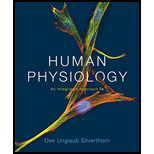
EBK HUMAN PHYSIOLOGY
7th Edition
ISBN: 9780133983401
Author: Silverthorn
Publisher: YUZU
expand_more
expand_more
format_list_bulleted
Concept explainers
Question
Chapter 22, Problem 10RQ
Summary Introduction
To determine: The various forms in which extra energy is stored in the body.
Introduction: Glucose is a simple sugar that gives energy to the body. Glucose travels through the blood to the body cells, and hence, it is called blood sugar. Insulin is responsible for the movement of glucose in the blood.
Expert Solution & Answer
Want to see the full answer?
Check out a sample textbook solution
Students have asked these similar questions
Please draw in the missing answer, thank you
Please fill in all blank questions, Thank you
please fill in missing parts , thank you
Chapter 22 Solutions
EBK HUMAN PHYSIOLOGY
Ch. 22 - Explain the roles of the satiety and feeding...Ch. 22 - Name the four layers of the GI tract wall,...Ch. 22 - Prob. 3CCCh. 22 - Prob. 4CCCh. 22 - Prob. 5CCCh. 22 - Prob. 6CCCh. 22 - Prob. 7CCCh. 22 - Prob. 8CCCh. 22 - Use your understanding of digestive physiology to...Ch. 22 - Prob. 10CC
Ch. 22 - Prob. 11CCCh. 22 - Prob. 12CCCh. 22 - What are the primary target tissues for insulin?Ch. 22 - Why are glucose metabolism and glucose transport...Ch. 22 - What is the advantage to the body of inhibiting...Ch. 22 - Prob. 16CCCh. 22 - Prob. 17CCCh. 22 - Prob. 18CCCh. 22 - Prob. 19CCCh. 22 - Prob. 20CCCh. 22 - Prob. 21CCCh. 22 - Prob. 22CCCh. 22 - Prob. 23CCCh. 22 - Prob. 24CCCh. 22 - Define metabolic, anabolic, and catabolic...Ch. 22 - Prob. 2RQCh. 22 - Prob. 3RQCh. 22 - Prob. 4RQCh. 22 - Define basal metabolic rate (BMR). Under what...Ch. 22 - Prob. 6RQCh. 22 - Prob. 7RQCh. 22 - What is a nutrient pool? What are the three...Ch. 22 - Prob. 9RQCh. 22 - Prob. 10RQCh. 22 - Prob. 11RQCh. 22 - Name the two hormones that regulate glucose...Ch. 22 - Which noncarbohydrate molecules can be made into...Ch. 22 - Under what circumstances are ketone bodies formed?...Ch. 22 - Name two stimuli that increase insulin secretion,...Ch. 22 - Prob. 16RQCh. 22 - What factors release glucagon? What organ is the...Ch. 22 - Prob. 18RQCh. 22 - Prob. 19RQCh. 22 - Prob. 20RQCh. 22 - Prob. 21RQCh. 22 - Prob. 22RQCh. 22 - Prob. 23RQCh. 22 - Prob. 24RQCh. 22 - Explain the current theory of the control of food...Ch. 22 - Prob. 26RQCh. 22 - Scott is a bodybuilder who consumes large amounts...Ch. 22 - Prob. 28RQCh. 22 - Prob. 29RQCh. 22 - One of the debates in fluid therapy for diabetic...Ch. 22 - Prob. 31RQCh. 22 - Prob. 32RQ
Knowledge Booster
Learn more about
Need a deep-dive on the concept behind this application? Look no further. Learn more about this topic, biology and related others by exploring similar questions and additional content below.Similar questions
- please draw in the answers, thank youarrow_forwarda. On this first grid, assume that the DNA and RNA templates are read left to right. DNA DNA mRNA codon tRNA anticodon polypeptide _strand strand C с A T G A U G C A TRP b. Now do this AGAIN assuming that the DNA and RNA templates are read right to left. DNA DNA strand strand C mRNA codon tRNA anticodon polypeptide 0 A T G A U G с A TRParrow_forwardplease answer all question below with the following answer choice, thank you!arrow_forward
- please draw in the answeres, thank youarrow_forwardA) What is being shown here?B) What is indicated by the RED arrow?C) What is indicated by the BLUE arrow?arrow_forwardPlease identify the curve shown below. What does this curve represent? Please identify A, B, C, D, and E (the orange oval). What is occurring in these regions?arrow_forward
- Please identify the test shown here. 1) What is the test? 2) What does the test indicate? How is it performed? What is CX? 3) Why might the test be performed in a clinical setting? GEN CZ CX CPZ PTZ CACarrow_forwardDetermine how much ATP would a cell produce when using fermentation of a 50 mM glucose solution?arrow_forwardDetermine how much ATP would a cell produce when using aerobic respiration of a 7 mM glucose solution?arrow_forward
- Determine how much ATP would a cell produce when using aerobic respiration to degrade one small protein molecule into 12 molecules of malic acid, how many ATP would that cell make? Malic acid is an intermediate in the Krebs cycle. Assume there is no other carbon source and no acetyl-CoA.arrow_forwardIdentify each of the major endocrine glandsarrow_forwardCome up with a few questions and answers for umbrella species, keystone species, redunant species, and aquatic keystone speciesarrow_forward
arrow_back_ios
SEE MORE QUESTIONS
arrow_forward_ios
Recommended textbooks for you
 Human Physiology: From Cells to Systems (MindTap ...BiologyISBN:9781285866932Author:Lauralee SherwoodPublisher:Cengage Learning
Human Physiology: From Cells to Systems (MindTap ...BiologyISBN:9781285866932Author:Lauralee SherwoodPublisher:Cengage Learning Human Biology (MindTap Course List)BiologyISBN:9781305112100Author:Cecie Starr, Beverly McMillanPublisher:Cengage Learning
Human Biology (MindTap Course List)BiologyISBN:9781305112100Author:Cecie Starr, Beverly McMillanPublisher:Cengage Learning Concepts of BiologyBiologyISBN:9781938168116Author:Samantha Fowler, Rebecca Roush, James WisePublisher:OpenStax College
Concepts of BiologyBiologyISBN:9781938168116Author:Samantha Fowler, Rebecca Roush, James WisePublisher:OpenStax College

Human Physiology: From Cells to Systems (MindTap ...
Biology
ISBN:9781285866932
Author:Lauralee Sherwood
Publisher:Cengage Learning


Human Biology (MindTap Course List)
Biology
ISBN:9781305112100
Author:Cecie Starr, Beverly McMillan
Publisher:Cengage Learning



Concepts of Biology
Biology
ISBN:9781938168116
Author:Samantha Fowler, Rebecca Roush, James Wise
Publisher:OpenStax College
What is Homeostasis? | Physiology | Biology | FuseSchool; Author: FuseSchool - Global Education;https://www.youtube.com/watch?v=quQr6X1Q58I;License: CC-BY